26th August, 2025
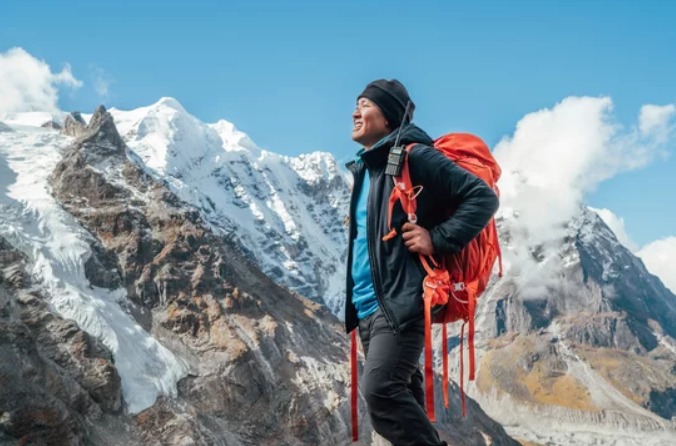
Mar 12, 2024
Mera Peak Climbing in August
- Mera Peak Climbing Permit and Cost in August
- Why Sherpa Expedition Has Everyday Availability for Mera Peak Climbing
- Preparation and Safety About Mera Peak
- Altitude Sickness and Acclimatization
- Highlights of Mera Peak Climbing In August
- Does Guide Give Us Training at Mera Khare
- Can I Hire Climbing Equipment at Khare
- Can I See Mount Everest From The Mera Peak Top
- Hiring a Down Jacket and Sleeping bag with Sherpa Expedition without any cost
- Why Should You Climb Mera Peak in August
- Mera Peak Weather, Climate, and Temperature in August
- Advantages to Climb Mera Peak in August
- What Should I Pack for Mera Peak Climbing in August
- Why Is Mera Peak Cost Low In August
- What Kind Of Training Do I Need to Do in Advance for Climbing Mera Peak
- Tips For Summiting Mera Peak
- Conclusion
- Mera Peak Climbing Packages
Climbing Mera Peak in August presents both challenges and rewards amidst Nepal's monsoon season. Standing at 6,476 meters (21,246 feet), Mera Peak offers adventurers a thrilling opportunity to conquer one of Nepal's highest trekking peaks, with panoramic views of Everest, Lhotse, Makalu, and the surrounding Himalayan giants.
August marks the peak of the monsoon in Nepal, bringing frequent rainfall and cloudy conditions. While this can pose challenges such as muddy trails and reduced visibility, August also offers unique advantages for climbers. The lush green landscapes and blooming flora create a vibrant backdrop along the trekking route, enhanced by the rejuvenating monsoon rains. The quieter trails compared to peak seasons provide a more serene and intimate trekking experience, allowing for deeper immersion in the natural beauty and cultural richness of the region.
Despite the weather variability, August can still provide clear weather windows, especially earlier in the month, offering opportunities for successful summit attempts. Climbers must be prepared for variable weather conditions and pack accordingly with waterproof clothing, sturdy trekking boots, and essential mountaineering equipment like crampons and ice axes.
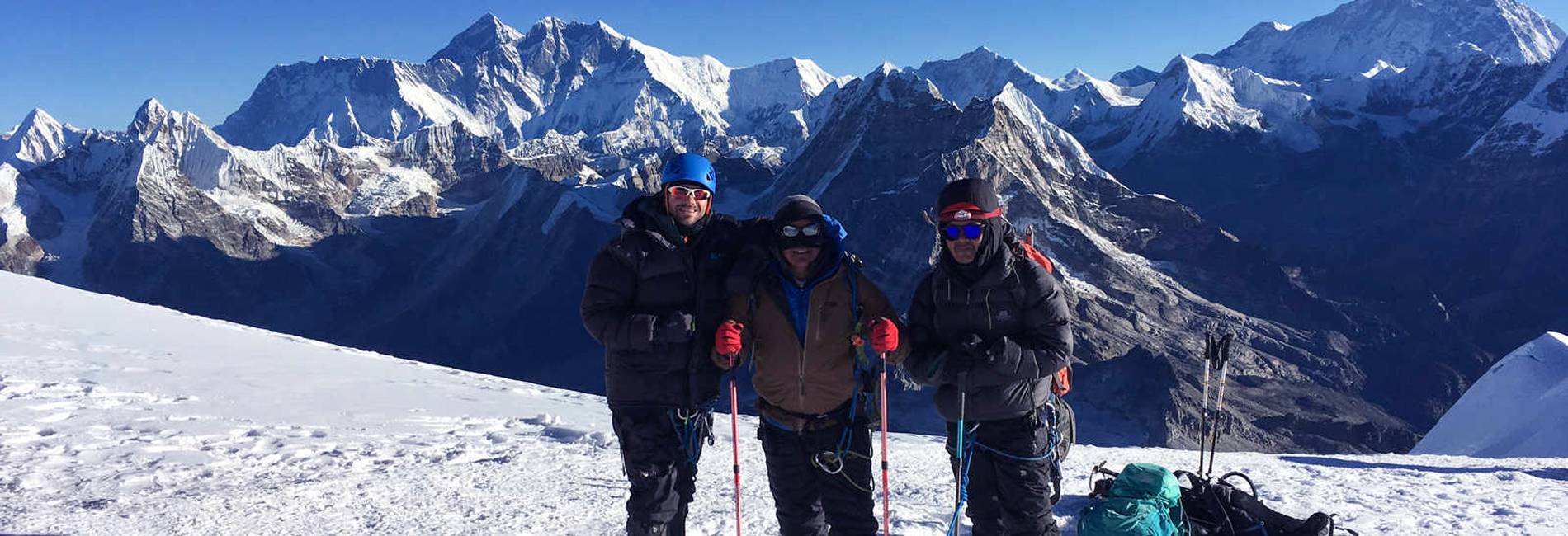
MERA PEAK CLIMBING
Mera Peak Climbing is an exhilarating adventure in Nepal that gives you an opportunity to reach the summit of Mera Peak at more than 6400m above sea level. Actually, it is the highest climbing (w...
Choosing experienced guides and reputable trekking agencies like Sherpa Expedition is crucial for navigating the challenges of climbing Mera Peak in August. Their knowledge of local conditions, safety protocols, and commitment to client satisfaction ensure a well-planned and supported expedition. With proper preparation and guidance, climbers can embrace the adventure of summiting Mera Peak in August, enjoying breathtaking views and forging unforgettable memories in the heart of the Himalayas.
Mera Peak Climbing Permit and Cost in August
Climbing Mera Peak in August requires obtaining permits from the Nepal Mountaineering Association (NMA). The permit cost for Mera Peak typically remains around USD 700 per person for foreign climbers during this month. This fee covers peak fees, garbage deposits, and administrative charges. Additionally, trekkers need permits for Sagarmatha National Park and local area permits, contributing to conservation efforts and supporting local communities. It's essential to obtain these permits through a reputable trekking agency like Sherpa Expedition to ensure compliance with regulations and responsible trekking practices amidst the challenges of the monsoon season.
Why Sherpa Expedition Has Everyday Availability for Mera Peak Climbing
Sherpa Expedition maintains everyday availability for Mera Peak climbing due to their extensive experience, logistical capabilities, and dedication to client satisfaction. They operate multiple expeditions throughout the climbing season, including August, accommodating varying trekker preferences and weather conditions. Their seasoned Sherpa guides possess intimate knowledge of Mera Peak's terrain and local weather patterns, enabling them to adjust swiftly to conditions and ensure safety. Sherpa Expedition prioritizes client safety and satisfaction by offering personalized itineraries, thorough acclimatization schedules, and comprehensive support during the ascent. Their commitment to excellence and safety allows them to offer reliable availability and successful summit opportunities for climbers of all skill levels, even during challenging months like August.

MERA PEAK CLIMBING 17 DAYS
This is an excellent opportunity to climb Nepal’s highest peak without having to obtain a permit (6,476m/21,190ft). From the summit, you will have stunning views of several 8000m plus peaks, such as E...
Preparation and Safety About Mera Peak
Preparation for climbing Mera Peak involves comprehensive physical conditioning, mental readiness, and understanding the high-altitude challenges inherent to Himalayan trekking and climbing. Sherpa Expedition emphasizes safety with detailed pre-departure briefings, equipment checks, and personalized training in essential mountaineering techniques. They provide necessary gear such as crampons, ice axes, and ropes, ensuring climbers are equipped to navigate snow and glacier terrain safely. Sherpa Expedition's experienced guides closely monitor climbers' health, implement effective acclimatization strategies, and offer support to manage altitude sickness symptoms. Their comprehensive approach to safety and preparation enhances climbers' chances of a successful and enjoyable expedition to Mera Peak, safeguarding both physical well-being and the overall adventure experience.
Altitude Sickness and Acclimatization
Altitude sickness, including symptoms like headaches, nausea, and dizziness, poses a significant risk when climbing Mera Peak in August due to its high altitude and the added challenge of the monsoon season. Sherpa Expedition prioritizes acclimatization with carefully planned itineraries that include gradual ascent and regular rest days. This allows climbers to adapt slowly to higher altitudes, reducing the risk of AMS (Acute Mountain Sickness) and ensuring a safer ascent. Guides closely monitor climbers' health throughout the expedition, providing guidance on hydration, nutrition, and recognizing symptoms. They are trained to respond promptly to medical emergencies, ensuring climbers' safety and well-being amidst the rigorous demands of climbing Mera Peak in August. Sherpa Expedition's expertise in altitude management and acclimatization strategies contributes to a successful summit experience while prioritizing the health and enjoyment of their clients.

MERA PEAK EXPEDITION 13 DAYS
Mera Peak is one of the most popular and highest trekking peaks in Nepal, standing at 6,476 meters. The Mera Peak expedition is a 13-day trek that takes you through some of the most breathtaking scene...
Highlights of Mera Peak Climbing In August
Climbing Mera Peak in August offers unique highlights despite the monsoon season. While weather conditions can be unpredictable with frequent rain and cloudy skies, August also presents lush green landscapes, blooming flora, and vibrant colors along the trekking route. The monsoon rains rejuvenate the scenery, creating picturesque waterfalls and streams cascading through the valleys. The quieter trails compared to peak seasons provide a more serene trekking experience, allowing for deeper immersion in the natural beauty and cultural richness of the region. Clear weather windows can offer stunning views of Everest, Lhotse, Makalu, and other Himalayan giants from Mera Peak's summit, rewarding climbers with breathtaking panoramas amidst the challenges of climbing in August.
Does Guide Give Us Training at Mera Khare
Sherpa Expedition provides essential training at Mera Khare, the last village before Mera Peak Base Camp. Experienced Sherpa guides offer instruction on using climbing equipment such as crampons, ice axes, and ropes. This training session ensures climbers are familiar with essential mountaineering techniques and safety procedures before tackling the more challenging sections of the climb. Training at Mera Khare also includes guidance on proper acclimatization, recognizing symptoms of altitude sickness, and maintaining health at higher elevations. Sherpa Expedition's comprehensive training approach aims to enhance climbers' confidence and readiness for the ascent to Mera Peak, ensuring a safe and enjoyable expedition.
Can I Hire Climbing Equipment at Khare
Yes, climbers can hire essential climbing equipment at Khare, the last settlement before Mera Peak Base Camp. Sherpa Expedition offers rental services for gear such as crampons, ice axes, helmets, harnesses, and ropes. Renting equipment at Khare provides convenience for climbers who prefer not to carry bulky gear throughout the trek or who need specific items they may not own. Sherpa Expedition ensures the quality and reliability of rented equipment, conducting regular maintenance and safety checks to guarantee climbers' safety and comfort during the ascent of Mera Peak. Hiring climbing equipment at Khare allows climbers to focus on the adventure and challenges of summiting Mera Peak while benefiting from professional gear and support from experienced guides.
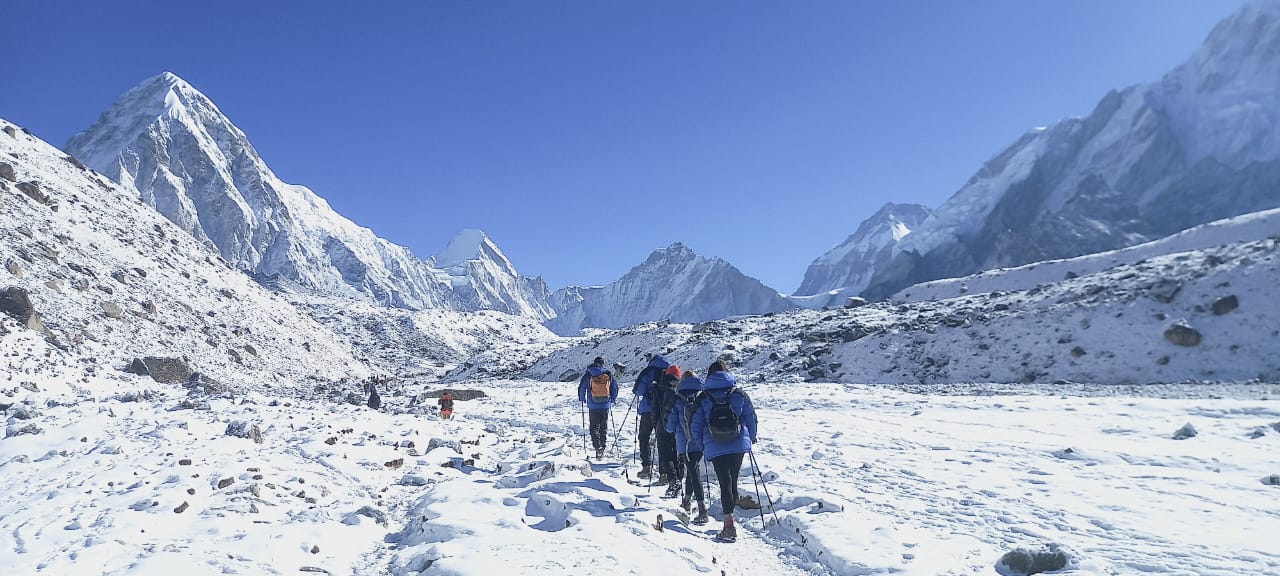
MERA AND ISLAND PEAK CLIMBING
Embark on a thrilling mountaineering adventure like no other with the Mera and Island Peak Climbing expedition crafted by We Sherpa Expedition and Trekking. This exclusive package is designed for adve...
Can I See Mount Everest From The Mera Peak Top
Yes, the summit of Mera Peak offers breathtaking views of Mount Everest (8848m), the world's highest peak, along with other prominent Himalayan peaks like Lhotse (8516m) and Makalu (8485m). On a clear day, climbers are rewarded with a panoramic vista stretching across the Everest region, showcasing the majestic snow-capped peaks and the vast expanse of the Himalayan landscape. The view from Mera Peak's summit is a highlight of the expedition, providing a sense of accomplishment and awe-inspiring beauty that captures the essence of Himalayan mountaineering. Sherpa Expedition guides ensure climbers have ample time at the summit to savor these unforgettable views, creating memories that last a lifetime amidst the serene and lofty heights of Mera Peak.
It's highly advisable not to rent a sleeping bag and down jacket from a renting shop when climbing with Sherpa Expedition and Trekking company. They provide top-quality equipment that is included in their comprehensive package. Sherpa Expedition ensures that all gear, including sleeping bags and down jackets, meets high standards for warmth, comfort, and safety in mountainous conditions.
Hiring a Down Jacket and Sleeping bag with Sherpa Expedition without any cost
Here's why relying on Sherpa Expedition's equipment is beneficial:
Quality Assurance: Sherpa Expedition maintains and updates their gear regularly to ensure reliability and performance. This includes insulation ratings appropriate for the cold temperatures encountered during the climb.
Fit and Comfort: Their equipment is selected to provide optimal fit and comfort, critical factors for restful sleep and warmth retention at high altitudes.
Safety and Reliability: By using their own equipment, Sherpa Expedition guarantees that all items are in excellent condition and have been tested in Himalayan conditions. This reduces the risk of gear malfunction or discomfort during the climb.
Convenience: Including sleeping bags and down jackets in the package simplifies logistics for climbers, eliminating the need to source and transport bulky gear from rental shops in Kathmandu or Lukla.
Overall, relying on Sherpa Expedition's equipment ensures climbers can focus on the experience and challenges of climbing Mera Peak without concerns about the quality or suitability of their gear. It's a reliable and convenient choice for enhancing safety and comfort throughout the expedition.
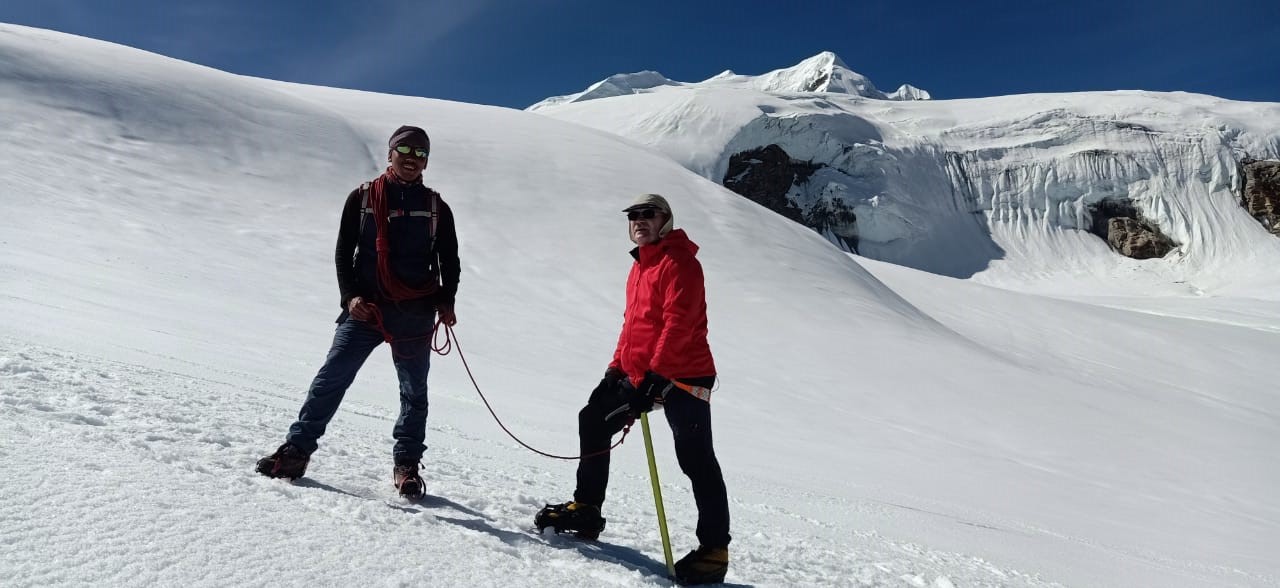
Mera Peak Climbing 20 Days
This is a chance to go climbing without the necessary permits that most climbing expeditions require in Nepal. Mera Peak fits the bill perfectly and at (6,476m/21,190ft) you will have spectacular view...
Why Should You Climb Mera Peak in August
Climbing Mera Peak in August offers a unique adventure amidst Nepal's monsoon season. Despite the occasional rain and cloudy skies, August presents lush green landscapes and vibrant flora along the trekking route. The quieter trails provide a more serene experience, allowing deeper immersion in the natural beauty and cultural richness of the region. August also offers opportunities for clear weather windows, providing stunning views of Everest, Lhotse, Makalu, and other Himalayan peaks from Mera Peak's summit. For adventurers seeking a less crowded trekking experience and the challenge of climbing during the monsoon, August provides a rewarding opportunity to conquer one of Nepal's highest trekking peaks.
Mera Peak Weather, Climate, and Temperature in August
August marks the peak of the monsoon season in Nepal, characterized by frequent rainfall and cloudy conditions. Daytime temperatures at lower elevations range from mild to warm, while nights can be cooler. At higher altitudes, temperatures drop significantly, necessitating warm clothing and proper gear for comfort and safety. Rainfall can make trekking trails muddy and slippery, requiring sturdy footwear and waterproof clothing. Despite the rain, August also offers occasional clear spells, allowing for summit attempts and breathtaking views from Mera Peak's summit. It's essential to be prepared for variable weather conditions and to pack accordingly with layers, waterproof gear, and adequate insulation to manage the climate challenges of climbing Mera Peak in August.
Advantages to Climb Mera Peak in August
Climbing Mera Peak in August offers several advantages for adventurous trekkers. The monsoon rains rejuvenate the landscape, creating lush greenery and blooming wildflowers along the trekking route. The quieter trails compared to peak seasons provide a more peaceful and intimate trekking experience, allowing for deeper connection with nature and cultural immersion in Sherpa villages. Despite the weather challenges, August still presents opportunities for clear weather windows, offering stunning views of the Himalayan peaks from Mera Peak's summit. Climbing in August also allows climbers to experience the unique challenges and rewards of trekking during Nepal's monsoon season, making it a memorable and rewarding adventure for those prepared for the conditions.

ISLAND PEAK CLIMBING
Sherpa Expedition & Trekking (Est.1977) are pleased to announce FOR ADVENTURERS the most awesome, exhilarating & unforgettable climbing and treks on offer anywhere today!...
What Should I Pack for Mera Peak Climbing in August
Packing for Mera Peak climbing in August requires careful consideration due to the monsoon season's variable weather conditions. Essential items include waterproof and windproof outer layers, sturdy trekking boots with good grip, and quick-drying base layers. Pack warm clothing for cooler temperatures at higher altitudes and nights, including insulated jackets, thermals, and a warm sleeping bag suitable for sub-zero temperatures. Sun protection such as sunscreen, sunglasses, and a wide-brimmed hat is crucial, along with a headlamp and spare batteries for early morning starts and evening hikes. A comprehensive first aid kit should include altitude sickness medication and personal medications. Energy snacks and hydration supplies are essential for maintaining energy levels on the challenging trek. Packing smartly ensures you're prepared for the diverse weather conditions and terrain challenges of climbing Mera Peak in August.
Why Is Mera Peak Cost Low In August
The cost of climbing Mera Peak is typically lower in August due to the monsoon season, which is considered an off-peak period for trekking and climbing in Nepal. With fewer climbers on the trail, trekking agencies may offer competitive pricing and discounts to attract adventurers looking to summit Mera Peak during this quieter season. Lower costs can also reflect reduced accommodation and transportation rates during the offseason. Despite the potential for rain and cloudy skies, August still offers opportunities for clear weather windows and successful summit attempts, making it a viable and cost-effective time to undertake the Mera Peak expedition. Choosing to climb Mera Peak in August combines affordability with unique trekking experiences, allowing climbers to enjoy the challenge and beauty of Nepal's Himalayas without the peak-season crowds.
What Kind Of Training Do I Need to Do in Advance for Climbing Mera Peak
Preparing to climb Mera Peak involves both physical conditioning and mental preparation. Focus on building endurance through aerobic exercises like hiking, running, and cycling to improve cardiovascular fitness. Strength training, including exercises for legs, core, and upper body, helps build muscle strength essential for carrying a backpack and using climbing equipment. Practicing with hiking boots and carrying a weighted pack simulates the conditions you'll encounter on the trek.
Mental preparation is crucial for enduring long days of trekking and the challenges of high-altitude climbing. Practice mindfulness, relaxation techniques, and mental imagery to maintain focus and manage stress during the climb. Familiarize yourself with basic mountaineering skills such as using crampons, ice axes, and rope techniques, which can be learned during pre-climb training or from experienced guides.
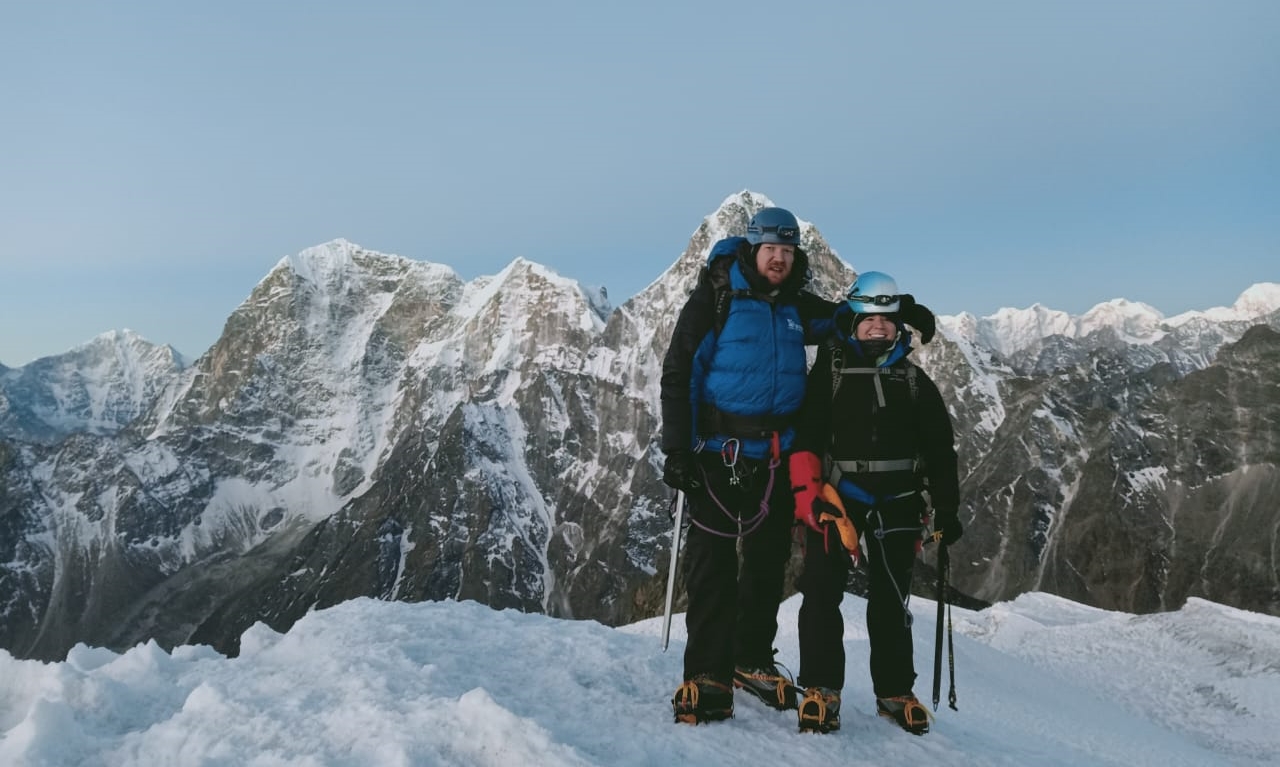
LOBUCHE PEAK CLIMBING
Lobuche East (6,119m/20,075ft), set in Nepal's stunning Khumbu on the Nepalese side of Everest.The best time to go trekking in Nepal is in Autumn (September-November) and in...
Tips For Summiting Mera Peak
Achieving a successful summit of Mera Peak requires careful planning, physical readiness, and adapting to mountain conditions. Start early on summit day to maximize daylight hours and avoid afternoon weather changes. Pace yourself and maintain a steady rhythm to conserve energy for the ascent. Stay hydrated and fueled with snacks to sustain energy levels throughout the climb.
Follow your guide's instructions for using climbing equipment and navigating snow and glacier terrain safely. Communicate any discomfort or symptoms of altitude sickness immediately to your guide. Dress in layers to regulate body temperature and protect against changing weather conditions. Take breaks as needed to rest and acclimatize properly.
Reach the summit with a sense of accomplishment but prioritize safety in all decisions. Enjoy the panoramic views from Mera Peak's summit before safely descending to base camp. Celebrate your achievement with your expedition team and cherish the memories of this challenging and rewarding Himalayan adventure.
Conclusion
Climbing Mera Peak is an exhilarating journey that combines physical challenge with breathtaking scenery in the heart of the Himalayas. Preparation is key to success, from training in advance to acclimatizing properly during the ascent. Choosing a reputable trekking agency like Sherpa Expedition ensures expert guidance, safety measures, and memorable experiences. Whether you're drawn to the thrill of high-altitude climbing or the natural beauty of Nepal's landscapes, Mera Peak offers a fulfilling adventure for adventurers seeking to conquer one of Nepal's highest trekking peaks. Embrace the challenges, savor the moments of achievement, and forge lasting memories on your expedition to Mera Peak.

LOBUCHE PEAK SUMMIT RETURN BY HELICOPTER
A real climbing adventure that will leave you stunned at the beauty of the Himalayan Mountains. The Lobuche Peak Climbing expedition in the spectacular Khumbu region of Nepal has been ranked by Lonely...
Mera Peak Climbing Packages
Mera Peak Summit Return By Helicopter

ISLAND PEAK SUMMIT RETURN BY HELICOPTER
Many of us only dream of standing on a tall peak looking down on the world. This is a great climb that will satisfy this desire. Island Peak, also referred to as Imja Tse, is a 6187-meter high peak in...
Any Questions? Let Us Know.
Recent Posts
17th June, 2025


















